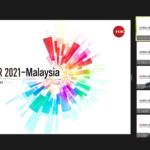On 4th April 2017, the new McAfee company began operating as a standalone cybersecurity business. With access to significant capital, operational and technology resources, thanks to the investment from TPG Capital and Thoma Bravo and continued strategic backing of Intel, McAfee emerges as one of the world’s largest pure-play cybersecurity companies.
McAfee’s Southeast Asia MD, Craig Nielsen chats with Enterprise IT News about the bigger picture as a result of this move.
EITN: What does the re-branding mean for McAfee?
Nielsen: McAfee’s award winning products and solutions today protect more than a quarter of a billion endpoints and secures the footprint for nearly two-thirds of the world’s 2,000 largest companies. With the joint ownership, McAfee will apply greater market focus, build its platform and target new financial, operational and technology investments to better address the cybersecurity market’s significant global growth opportunity.
In the words of our Chief Executive Officer Christopher Young: “McAfee’s newfound independence gives it (the company) the agility to unite people, technology and organisations against common adversaries and ensure that our technology-driven future is safe. “
As we embark on a new chapter in McAfee’s 30-year history, we unleash a company with a razor sharp focus on innovation, trust and collaboration. Serving our customers and enabling them to more effectively identify and orchestrate responses to cyberthreats is McAfee’s utmost priority.
EITN: Why the change back to McAfee? What does TPG’s investment bring business-wise and technology-wise?
Nielsen: The change back to McAfee signifies the company’s independence as an organisation that is wholly focused on security. The McAfee name has enormous and valuable equity in the security space. McAfee will continue to build on the reputation of the McAfee brand, which brings experience and expertise in security and equities of protection and safety.
TPG is a leading global alternative asset firm founded in 1992 with over $70 billion of assets under management and offices around the world. TPG is a seasoned technology investor that was attracted to McAfee’s industry leading cybersecurity solutions, its current business momentum and long-term potential. Together, TPG, Intel, and partners are committed to building McAfee as the best cybersecurity company in the industry.
EITN: How will the company continue to deliver on its strategic vision to provide an open and integrated system that reduces security fragmentation and automates tasks to more effectively block, identify and respond to threats, with concerted attention on the endpoint?
Nielsen: At its core, our strategy is based on a simple concept: to create an integrated security system that automates the threat defense lifecycle so customers can address more threats faster with fewer resources. With the recent announcement of our strategic partnership with TPG, we’re empowered to further define our strategy, demonstrate our unique position in the market and aggressively work to make IT security more dynamic and responsive to today’s most severe threats than ever before.
McAfee will continue to be very focused on consumers and enterprise customers. The strategy to integrate, automate and orchestrate the threat defense lifecycle to drive better security outcomes thus ultimately reducing more risk, faster and with fewer resources, outlined at our annual security conference, FOCUS 16, will remain the same.
Led by McAfee’s belief that “Together is Power”, we strongly believe that only when people, technology and organisations work together can we become safer. Under our strategic vision, we are committed to bringing the most holistic security solutions to the forefront. Moving beyond piecemeal features, McAfee solutions provide consumers, businesses and governments with end-to-end protection from the most advanced threats.
We remain committed to enabling a safe and connected world by providing an open and integrated system that best enables organisations to effectively block threats, identify compromises, and expedite remediation. This is achieved by building on McAfee’s leading endpoint protection solutions, diverse technologies, and widely adopted and open centralised management platform, to expedite the entire threat defense lifecycle.
Customers today expect endpoint security to deliver more than just malware scanning and demand deeper, richer visibility and inspection capabilities on computing devices. Customers want endpoint security to become a platform for capabilities such as forensics, to provide behavior analytics, and instead of searching for malicious files, look out for behavior that might constitute malicious behavior. Our experience with Intel puts us at a position of strength to extend these capabilities to any computing platform, be it servers or IoT devices in the home.
EITN: What is your stance when it comes to machine learning and artificial intelligence
Nielsen: In our McAfee Labs 2017 Predictions report, we identified machine learning as one trend that is accelerating social engineering attacks. We believe that cybercriminals are leveraging machine learning to target victims. Tools to perform the complex analysis behind target selection are readily available, and there are a plethora of public sources of data required to build and train malicious machine learning algorithms.
In 2016 alone, there have been breaches involving 30,000 US Department of Justice employees, 1.5 million Verizon Enterprise Solutions customer records, and nearly 150 million accounts leaked from major email providers including Yahoo, Hotmail and Gmail, to name a few. The data from many of these breaches has been commoditised and sold in open markets, as is the case with leakedsource.com, which claims to have a little more than two billion records in their database.
Between social media information, stolen data warehouses and publicly disclosed business information, attackers have access to volumes of data to train predictive models to identify high-value targets, according to Eric Peterson, a researcher at McAfee Labs.
Looking to 2017 and beyond, we might even see purveyors of data theft offering “Target Acquisition as a Service” built on machine learning algorithms. We expect that the accessibility of machine learning will accelerate and sharpen social engineering attacks in 2017.
From a security solution perspective, vendors like McAfee will begin to use machine learning to predict and stop attacks before they have done harm. Security solutions that protect the cloud infrastructure itself will become extremely critical, because compromising the infrastructure delivers direct access to the applications and data of multiple customers. The volume of events will be overwhelming, so we will see continued development of sophisticated, automated tools that can quickly diagnose and resolve incidents. Building on those using machine learning and big data analytics, security solutions will become predictive and prescriptive, helping detect emerging threats and stop attacks well before systems are compromised.
Human-machine teaming is going to become critical in any cyber security operation, and McAfee sees its strategic goal of enabling security technologies to work together as an important way of helping to drive human-machine teaming.
EITN: How does all of the above translate into for APAC?
Nielsen: McAfee’s status as a new standalone cybersecurity company positions the company to capitalise on the significant global growth opportunities in cybersecurity. Asia Pacific is a hyper-growth market for McAfee, particularly South East Asia and India. For us, we have seen both markets achieve double-digit growth for the past two years and expect this growth to continue moving forward. The company continues to invest in putting in additional resources to address the demand in this region. The appointment of Ian Yip as chief technology officer for Asia Pacific will drive McAfee forward to the benefit of individuals, organisations and governments across the Asia Pacific Region. This will solidify McAfee as the standout cybersecurity solution that helps customers in this region to achieve the business outcomes, while maintaining the appropriate level of protection.
Asia Pacific will continue to be a key region for McAfee as it has been identified as a “high risk” region. Cyber security growth in Asia in 2016 -2016 is expected to reach $1.5B, growing 1% YoY and 4.8% CAGR (17-20) to reach $1.8B by 2020. APAC spent $230B on cybersecurity breaches in 2014, the highest amount for any region in the world, and 48% of ASEAN organisations have encountered a data breach or failed a compliance audit, well above the global average.
With Asia Pacific having a split between mature markets like Singapore and Australia who see greater cloud adoption, there are also geographies in the region who lag in terms of technological adoption and security levels. We are heartened to see governments stepping up to help in the cybersecurity framework by creating regulation, offering directives to citizens and organisations to be better stewards in securing data. To that aspect, McAfee welcomes the partnership and is fully committed to supporting Asia Pacific in these initiatives.








